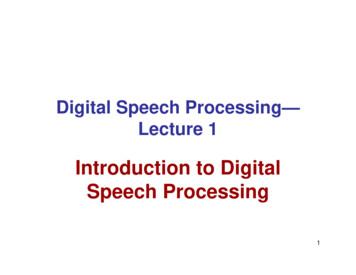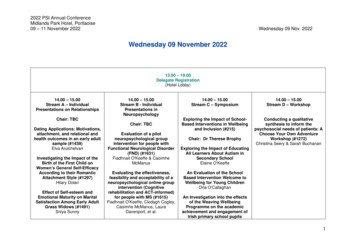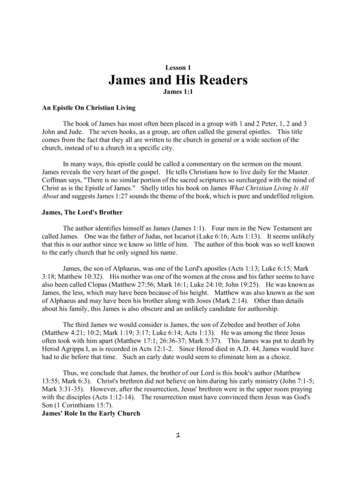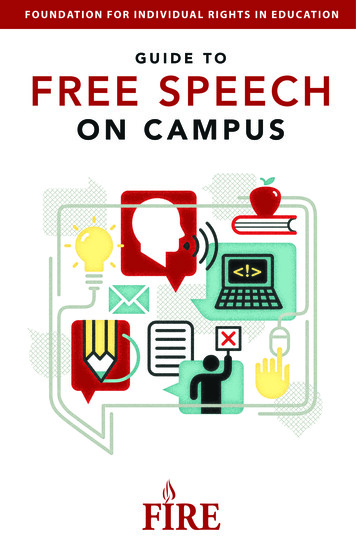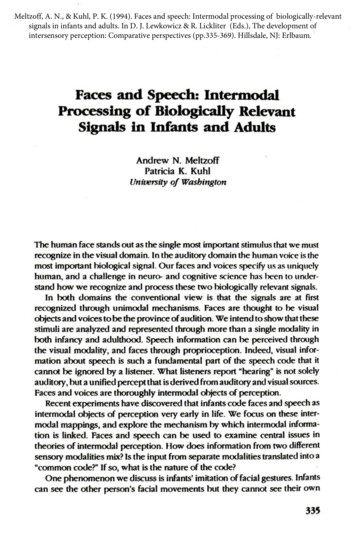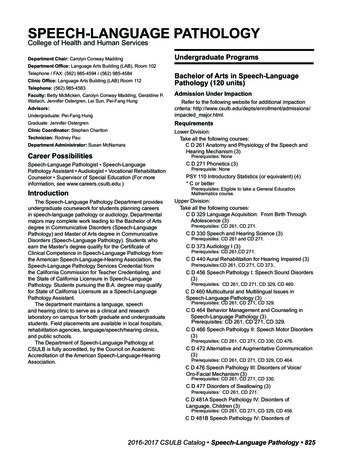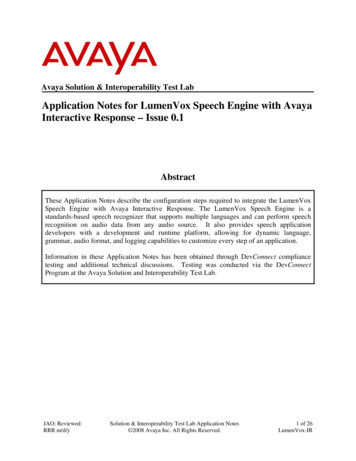
Transcription
.SPEECH.MONOGRAPHSPublishedby THE SPEECH COMMUNICATION AsSOCIATIONVOLUME XXXVIINOVEMBER,No.41970The Rhetoric of theReport from h-on J\1.ountainRAY LYNN ANDERSON.PAUL A. BAREFIELDRepublican KeynotersThe Elements of Thomas De Quinccy'sRhetoricWELDON B. DURHAMAn Analysis of Interaction Structure in theDiscussion of a Ranking TaskPatterns of CommunicativeSmall GroupsERNEST L. STECHInteraction inThe Effects of Response Set and Raceon Message InterpretationROBERT N. BOSTROMMICHAELBURGOONSPECIAL REPORTS''C- -.Measures of Communication-BoundAnxietyJAMES C. MCCROSKEYThe Relationship Between Affect and Importancein Attitude MeasurementSTUARTJ. KAPLANIndices of Opinionated and Orienting Statementsin Problem-Solving DiscussionsJOHN KLINEEffect of Sex on ComprehensionROBERTJ. KIBLER,and RetentionLARRYL. BARKER,and DONALDJ. CEGALAIndex to Volume XXXVII-
SPECIAL REPORTSMEASURESOF COMMUNICATION-BOUND--ANXIETYJAMES C. McCROSKEYThe Ad Hoc Committeeon Evalua-tion in speech communicationwasformed by the Speech Association ofAmerica and charged with the responsibility to examine the needs of the fieldin evaluation and meas rement. Amongthe recommendations of this committeewas the following:Since many problems in speech communicationpedagogy may result from students' inhibitionsrather than their inability, we recommend thedevelopment of instruments to measure at various ages the extent of communication-boundanxiety.1The purpose of this paper is to reportthe development of several measures ofcommunicationapprehension.Thesemeasures were developed as a part of acontinuingresearch program investigating the effects of systematic desensitization on communication apprehension.TyPES OF CoMMUNICATION-BoUNDA.'lXIETY."c. -The first concern in the developmentof measures of communication-boundanxiety is to determine what to measure.An examination of the literature con cerning "stage fright" indicates that thisterm is usually used to refer to anxietyin a public speaking situation. An inMr. McCroskey is A.ssociate Professor and Director of Graduate Studies in S1?eechCommunication at lllinois State Universdy. Early phasesof this research were supported by an A.llUniversity Research Grant from Michigan StateUniversity.1 "Research Notes," Spectra, V (December,1969), 3-4.strumentdesigned by Gilkinsontomeasure this type of anxiety has beenavailable for years)! More recently, ashorter form of this early instrument hasbeen reported by Paul. 3Friedrich, however, on the basis offactor analytic research, has suggestedthat these instruments are not unidimensional.4 His analysis produced threefactors for males which he labeled"speech anxiety," "exhibitionism,"and"reticence."The analysis for femalesubjects produced four factors, the samethree as for males plus one labeled"physical manifestations." Whether thesefactors are "real" dimensions of communication-bound anxiety remains to bedetermined. A careful examination ofthe results of Friedrich's analysis suggests that they may not be. The first tWofactors for both males and females accounted for most of the explained variance. Although these two factors wereassigned labels that suggest independentdimensionsof communication-boundanxiety, an examination of the items included in the tWo factors indicates thatthe most significant difference betweenthe tWo groups of items is that the majority of the items in the "speech anxiety" factor are negatively worded (allbut three of the 23 items for the male2 Howard Gilkinson. "Social Fears as Reported by Students in College Speech Classes,"Speech Monographs, IX (1942), 141-160.3 Gordon L. Paul, InsIght Versus Desensiti- %I1tion in Psychotherapy (Stanford: StanfordUniversity Press, 1966).4 GustaV W. Friedrich, "An Empirical Explication of a Concept of Self-Reported SpeechAnxiety," Speech Monographs, XXXVII (1970),67-72.
2iO-"---SPEECHMONOGRAPHSgroup and all but seven of 22 for thefemale group), while almost all of theitems in the "exhibitionism"factor arepositively worded (all 26 of the items forthe male group and all but one of the29 items for the fema e group).One of the major problems with thefactor analytic technique is that it willalmost always indicate multidimensionality, whether such multidimensionalityis actually present or not. Analyses Ihave performed, which included manyof the same items tested by Friedrich,produced conflicting results. When factor analyzed in conjunction with scalesknown to measure another variable(test anxiety), the items on factors oneand two. in the Friedrich analysis weremaintainedin a single, stable factor.However, when factor analyzed withoutthe unrelated items, the previously stable factor separated into two factorscomparable to those obtained by Friedrich. Although there is an obvious needfor more research to determine the dimensionality of the Gilkinson and Paulinstruments, both Friedrich's and myfindings suggest that multidimensionality must be a major. concern in thedevelopment of any new instruments.Even if we are to grant the unidimensionality of the Gilkinson and Paul instruments, there is need for the development of additional instruments. Theirinstrumentsfocus on communicationbound anxiety in only one contextpublic speaking. There are good reasonsto believe that this is not the only context in which anxiety can interfere withcommunication, and possibly it is noteven the most important context. Theextended case study research of Phillipsprovides us with an excellent picture ofthe individualwith communicationboundanxiety./I Phillipsuses the term/I Gerald M. Phillips. "Reticence: Pathologyof the Normal Speaker," Speech Monographs,XXXV (1968). 39.49."reticent"and avoids talking about"stage fright" in the usual sense. He defines the reticent individual as "a personfor whom anxiety about participation inoral communication outweighs his projection of gain from the situation."6Such people not only evidence the normal "stage fright" behaviors related topublic speaking, they also experienceproblems in communicatingin smallgroups and in interpersonal transactions.They tend to avoid communicating asmuch as possible.The work of Phillips suggests. abroadly based anxiety related to oralcommunication rather than a variety of"types" of communication-boundanxiety. I have labeled this phenomenon"communication apprehension." The development of instruments to measurecommunication apprehension has beenbased on the assumption that the phenomenon being measured is unidimensional. However, factor analysis has beenemployed consistently as a test of multidimensionality. The results of such testsare discussed below.CHOICEOF MEASUREMENTApPROACHResearchers have used three types ofinstruments to measure communicationbound anxiety: observer ratings, devicesfor indexing physiological changes, andself-report scales.1 As Clevenger hasnoted, these measures do not appear tomeasure the same thing; the correlations between the various types of measures are typically very low.8 My choiceof measurement approach was made bya process of elimination. Observer rat- jngs were excluded first because of thenotorious difficulty in obtaining reliableratings and, most importantly, because-6 Phillips. p. 40.1 Theodore Clevenger. Jr., "A Synthesis ofExperimental Research in Stage Fright," Quarterly journal of Speech, XLV (1959). 134-145.8 Clevenger. p. 138.
271SPECIA.L REPORTSsuch ratings must necessarily be basedon observable behaviors. Many behaviors presumed to be related to communication apprehension are either impossible or, at best, extremely difficult toobserve. These behaviors relate to thewithdrawaltendency associated withcommunicationapprehension.The severely anxious person is likely not tocommunicate at all in a given instance;thus no rating comparable to one foractual communication could be assigned.Even if this problem could be overcome,there would be a need to observe an individual in a number of communicationcontexts if an index of communicationapprehension across contexts were to beobtained. Because of all of these difficulties, the observer rating approach wasconsidered inappropriate.Because the primary need for instrumentationfor communicationapprehension is a measure that can be administered easily to large numbers of individuals at low cost, physiological indexeswere also ruled out. Mechanical devices''''--for indexing physiological changes arerelatively expensive and not available onmany college campuses or in most elementary and secondary schools. Equallyimportant,mechanicaldevices havesome of the same difficulties as observerratings. It is very difficult, if not impossible, to obtain physiological indexes during some communicationtransactions.reliable physiologicalAnd to obtainindicant of communicationapprehension would necessitate obtaining indexesfrom a variety of types of communication transactions. In addition, physiological indexes are inherently incapableof. measuring withdrawal responses in anactual communication environment.aBecause of the aforementionedproblems with the other approachestomeasurement of communication-boundanxiety, I selected the self-report scalesapproach,specifically the Likert-typescale. This approach has three majoradvantages. First, such scales are easyand inexpensive to administer. Second,they can tap anxiety responses across avariety of communicationcontexts atone time. Third, Likert-type self-reportscales, when properly developed, normally are highly reliable. Validity ofsuch scales is often questioned, however.This problem will be considered below.THESCALES AND THEIRDEVELOPMENTFour scales have been developed.Three of the scales, each for a differentage level, are intended to measure thebroadly-based anxiety referred to aboveas communicationapprehension.Thefourth scale was designed to measureanxiety only in the public speaking con.text. The four scales are: the PersonalReport of CommunicationApprehension for College Students (PRCA-College), the Personal Report of Communication Apprehension for Tenth Graders(PRCA-Ten), the Personal Report ofCommunication Apprehension for Seventh Graders (PRCA-Seven), and thePersonal Report of Public Speaking Apprehension (PRPSA). These instrumentsare shown in Tables 1-4. The proceduresemployed in their developmentandother pertinentinformationare dis-cussed below.-PRCA-College. The PRCA-College instrument has received primary attentionbecause of the need for this instrumentin a continuing research program. Aninitial pool of 76 Likert-type items wasgenerated. Thirty of these were takenintact from the Paul version of Gilkin- .;.son's PRCS instrument. The remainingitems were written by graduate studentsin speech and me. These items focusedon interpersonal communication(e.g.,conversing with an acquaintance), smallgroup communication(e.g., participation in a group discussion), and a few
272SPEECH MONOGIU.PHSTABLE IPRCA-CoLLECEThis instrument is composed of 20 statementsconcerning feelings about communicating withother people.Indicate the degree to which the statementsapply to you by marking whether you (1)strongly agree, (2) agree, (3) are undecided, (4)disagree, or (5) strongly disagree with eachstatement. Work quickly, just record your firstimpression.1. While participating in a conversation witha new acquaintance I feel very nervous.2. I have no fear of facing an audience.3. I look forward to expressing my opinion atmeetings.4. I look forward to an opportunity to speakin public."5. I find the prospect of speaking mildlypleasant.-"- -.6. When communicating, my posture feelsstrained and unnatUral.7. I am tense and nervous while participatingin group discussions.8. Although I talk fluently with friends I amat a loss for words on the platform.9. My hands tremble when I try to handleobjects on the platform.10. sIble.I. always avoid speaking in public if posII. I feel that I am more fluent when talkingto people than most other people are.12. I am fearful and tense all the while I amspeaking before a group of people.13. My thoughts become confused and jumbledwhen I speak before an audience.14. Although I am nervous just before gettingup, I soon forget my fears and enjoy theexperience.15. Conversin with people who hold positionsof authonty causes me to be fearful andtense.16. I dislike to use my body and voice expressively.Ii. I feel relaxed and comfortable while speaking.18. I feel self-conscious when I am called uponto answer a question or give an opinion inclass.19. I face the prospect of making a speech withcomplete confidence.20. I would enjoy presenting a speech on alocal television show.extreme public speaking situations (e.g.,giving a speech on television). The resultant pool of items represented a crosssection of communicationcontexts.There were also some items that did notrelate exclusively to anyonecontext(e.g., "I dislike to use my body and voiceexpressively").These items were administered in atypical five-choice response format to ap--proximately 250 college students. Theresponses were subjected to principalcomponents factor analysis and varimaxrotation. The result of this analysis indicated three factors, The first factor accounted for 57 per cent of the totalvariance of scores and the remainingfactors accounted for approximately6per cent each. Most of the variance isolated in the second and third factors wascontributedby secondary loadings. ofitems with their primary loadings on thefirst factor. No item loaded higher than.50 on either the second or third factor.It was impossible to distinguish anycharacteristics of these factors whichclearly disinguished them from the primary factor. Thus the items with theirhighest loadings or moderate secondaryloadings (.40 or above) on these factorswere discarded. The 20 items with thehighest factor loadings on the primaryfactor (all above .50) were selected tocompose the initial instrument.Over a period of a year the instrumentwas administered to 1,434 college students at Michigan State University. Internal consistency reliability estimates(odd-even) ral).ged from .92 to .94. Testretest reliability over a ten day period(N769) was .83.The Test Anxiety Inventory9 was administered to 542 Michigan State students along with the PRCA-College. Although the scores on the two instrumentswere significantly correlated (.32), factoranalysis with varimax rotation indicatedthat the items on the two measures load- ed on separate factors. The analysis produced two factors, each of which accounted for about 35 per cent of thecombined variance. All of the items ofthe PRCA-College instrument loaded onone factor, all of the items on the Test9 J. R. Emery and J. D. Krumboltz, "Standard Versus Individualized Hierarchies in Desensitization to Reduce Test Anxietv," Journalof Counseling Psychology, XIV (1967), 204-209.-
273SPECIAL REPORTSAnxiety Inventory loaded on the otherfactor. In a separate analysis of thesedata, not including the scores from theTest Anxiety Inventory,two factorswere observed on the PRCA-College instrument. All of the items with theirhighest loading on the first factor werepositively worded, all but one of theitems on the second factor were negatively worded. On the basis of these results, I believe it is more defensible toconclude that the PRCA-College is unidimensional than that it is multidimensional.The instrument subsequently was administered to 2,479 college students atIllinois State University. In the firstadministrationat Illinois State (N1,12i) ten additional items were addedto the instrument to determine whetherthey would affect the results obtained.An analysis of the resulting data indicated that all but one of the original20 items had a sufficiently high itemtotal correlation to be retained in the instrument. This item had a relatively lowitem-total correlation(.28), and al- though this correlation was significant atthe .01 level it did not meet the preset.001 criterion. The item also was found(on the basis of a t-test between the 27per cent of the students with the highestscores and the 27 per cent with the lowest scores) to be nondiscriminating. Theobserved difference was significant at the.05 level but not at the preset criterionof the .001 level. Although the itemcould have been retained without seriously harming the total instrument, itwas discarded in favor of one of the newitems which had an item-total cor.relation of .72 and met the criterion for discrimination. Figure I shows a frequencydistributionof scores for the 2,479Illinois State University students whohave completed the instrument.The1,434 Michigan State students are notincluded because they completed the instrument with the item that was subsequently discarded. The frequency distribution for the Michigan State students, however, is almost exactly thesame as the one in Figure 1. The distribution is approximatelynormal. The"01360I '190II'alSO»l70 '8160 150 JJ.O'::130120I 08070 I60co40;020100 f ;30J,40!6 05S606SP!!CAScore. Groupe4 in Intor'l'WFIGUREI. Frequenc)'Distributionof PRCA-College707S808S90oC S UnitaScores for 2479 Illinois State UniversityStudents
274SPEECH MONOGRAPHS-PRCA-ColIege is no exception. An examination of the items. included iil the instrument and the procedures employedin the development of the instrumentare suggestive, of course, of face validity.Determining validity on the basis of correlations of the PRCA-Collegewithgroup again produced a two-factor soluother measures was discounted becausetion. As was the case with the data fromof the absence of other measures of highthe Michigan State students, one factorwas composed of positively worded items enough quality to serve as criterion variand the other was composed of nega- ables. For example, observer ratingswere discounted as a criterion variabletive!y worded items. These two factorsbecause of both their unreliability andare comparable to the first two obtainedby Friedrich in his analysis of the Gil- the impossibility of observing some of thebehavioral syndromes which would. bekinson instrument.tO I do not believe,however, that these results properly can anticipated as a result of high communication apprehension,e.g. withdrawal.be interpreted as an indication of multiSimilarly,physiologicalindicants weredimensionality.Rather,I interpretrejectedbecauseofthedifficulty,if notthese results (as well as those reportedby Friedrich) to be indicative of two impossibility, of creating comparablesituations for measurement between theresponse patterns relating to item wordself-report and the physiological indiing rather than item content.cant. A crude, but suggestive, indicantScoring this instrument in the usualof validity was provided by one instruc1-5 manner (1 indicating least appretor at Illinois State University. In thishension, 5 indicating most) yields a poinstructor's classes students were assignedtential range of scores from 20 to 100.to participate in group discussions inThe hypothetical neutral position in thegroupsof six. The students then rankedinstrument is 60.0. Determining whatthemselves a.nd the other members ofan individual score means is speculativetheir group in terms of their quality ofat best. Any score higher than 60 sugparticipation. All of the highly-anxiousgests the presence of more than averagestudents, according to the PRCA-Collegeapprehension. Exactly how much apinstrument, were ranked by the otherprehension a person must have before hemembersof their group either fifth orcan be considered to have "abnormal"sixth, as would be expected.apprehension is another matter. SubjecIn summary, the PRCA-College intive observation of students who havestrument is reliable and has some indibeen involved in our research programsuggests that individualswith scores cation of validity. Because it employsthe Likert approach to measurement,higher than 70 (approximatelyonestandard deviation above the mean) are the data which it yields normally wouldbe considered interval. It appears that';'almost always highly anxious. Subjectsscoring over 80 (approximatelytwo this instrument is of sufficient quality tostandard deviations above the mean) can be employed in research on communication apprehension among college stube described as severely apprehensive.dents.Determining the validity of any selfPRCA-Ten. The PRCA-Ten was de.report measure is difficult, and theveloped subsequent to the developmentof the college instrument. The collegeto Friedrich, pp. 69.71.mean for the 2,479 ISU students is60.45, the standard deviation is 11.58.The internal consistency (odd-even) reliability estimate is .93.Factor analysis and varimax rotation.of the data from the total Illinois State.
275SpECIAL REPORTSinstrument was taken as the base forPRCA-Ten. Some of the items were reworded to be more appropriate for individuals at this age level and ten itemswere added that appeared to be relevantto communication experiences of tenthgraders. This instrument was administered to 123 tenth graders in the University High School in Normal, Illinois.The items selected for PRCA-Ten (seeTable 2) included several that were notTABLE 2PRCA.TE:-IThis instrument is composed of 20 statememsregarding feelings about comumnicatingwithother people:Indicate the degree to which the statementsapply to you by markingwhether you. (1)strongly agree, (2) agree. (3) are undecided.(4) disagree. or (5) strongly disagree with eachstatement. 'Work quickly, just record your firstimpression.1. While participatingin a conversation witha new acquaimanceI feel very nervous.2. I seek out the opportunityto converse withother people.3. When I talk with a member of the opposite.sex who is near my own age. I feel quitenervous.4. I have no fear of facing an audience.5. I look forward to expressing my opinionat meetings.6. I look forward to an opportunityto speakin public.-.7. I enjoy meetingand talking with newpeople.8. I am tense and nervous while participatingin group discussions.9. Although I talk fluently with friends I amat a loss for words on the platform.10. My hands tremble when I try to handleobjects on the platform.11. I prefer not to talk with people unless Iknow them well.12. I always avoid speaking in public if pos.sible.13. I feel that I am more fluent when talking topeople than most other people are.14. I am fearful and tense all the while I amspeaking before a group of people.15. My thoughts become confused and jumbledwhen I speak before an audience.16. Although I am nervous just before gettingup. I soon forget my fears and enjoy theexperience.17. Conversing with people who hold positionsof authority causes me to be fearful andtense.18. I feel relaxed and comfortable while speak.ing.19. I face the prospect of making a speech withcomplete confidence.20. I would enjoy presentinga speech on alocal television show.on the original college instrument. Thebasis for selection was item total correlations and t-tests of discrimination.The items selected all had item-totalcorrelations of .50 or higher and discriminated beyond the .001 level. The internal reliability estimate (N123) forthe 20 items selected for the measurewas .88. No test-retest reliability estimatehas yet been obtained.PRCA-Seven. The development of thePRCA-Seven instrumentfolowed thesame procedure used for PRCA-Ten.The 30 items were administered to. 72seventh graders in Metcalf Junior HighSchool, Normal, Illinois. Items selectedfor PRCA-Seven (see Table 3) were selected on the same basis as above. Theinternal reliability estimate (N72)for the 20 items selected for this measurewas .87. No test-retest reliability estimateis as yet available. TABLE 3PRCA.SEVE:-IThis instrument is composed of 20 statementsconcerning feelings about communicatingwithother people.Indicate the degree to which the statementsapply to you. by marking whether you (1)strongly agree, "(2) agree, (3) are undecided. (4)disagree, or (5) strongly disagree with eachstatement. Work quickly, just record your firstimpression.1. While participatingin a conversation witha new acquaintance I feel very nervous.2. Talking with people is one of my favoritepastimes.3. I have no fear of facing an audience.4. I look forward to expressing my opinion atmeetings.5. I look forward to an opportunityto speakin public.6. I find the prospect of speaking mildlypleasant.7. Whencommunicating,my posturefeelsstrained and unnatural.8. I enjoy meeting and talking with new peo-pIe.9. I am tense and nervous while participatingin group discussions.10. AlthoughI talk fluently with friends Iam at a loss for words on the platform.11. My hands tremble when I try to handleobjects on the platform.12. I prefer not to talk with people unless Iknow them well.13. I always avoid speaking in public if possible.
SPEECH MONOGRA.PHS27614. I am fearful and tense all the while I amspeaking before a group of people.15. My thoughts become confused and jumbledwhen I speak before an audience.16. Conversin with people who hold positionsof authonty causes me to be fearful andtense.17. I feel relaxed and comfortable while speaking.18. I enjoy preparing a talk.19. I face the prospect of making a speechwith complete confidence.20. I would enjoy presenting a speech on alocal television show.PRPSA. The PRPSA was developedby substituting public speaking situations for test situations in an instrumentused by Emery and Krumboltz to measure test anxiety.!l The test anxiety instrument has been used in a number ofstudies and found to be reliable. It is aLikert-type scale which, when scored inthe usual 1-5 manner, yields scores witha potential range of 34 to 170. The hypothetical neutral position is 102. Thisinstrument was selected as the base forthe PRPSA because it provided an excellent variety of anxiety stimuli whichcould be revised to relate to publicspeaking. The original intent was toproduce a shorter form of about 20items selected from the original 34. However, item analysis and factor analysis769) indicated that all of the items(Nwere discriminating and all loaded on asingle factor. Thus, the entire group of34 items was retained in the instrument.The PRPSA was administered to 945students in a public speaking course atMichigan State University, and employed as a secondary measure in three .'c. .TABLE 4PRPSAThis instrument is composed of 34 statementsconcerning feelings about communicatingwithother people.Indicate the degree to which the statementsapply to you by markingwhether you (I)strongly agree. (2) agree, (3) are undecided,(4) disagree, or (5) strongly dISagree with each11 Emery and Krumboltz.statement. Work quickly. just record your firstimpression.1. While preparing for giving a speech I feeltense and nervous.2. I feel tense when I see the words "speech"and "public speech" on a course outlinewhen studying.3. My thoughts become confused and jumbledwhen I am giving a speech.4. Right after giving a speech I feel that Ihave had a pleasant experience.5. I get anxious when I think about a speech6.coming up.I have no fear of giving a speech.7. Although I am nervous just before startinga speech. I soon settle down after startingand feel calm and comfortable.8. I look forward to giving a speech.9. When the instructor announces a speakingassignment in class I can feel myself getting tense.10. My hands tremble when I am giving aspeech.11. I feel relaxed while giving a speech.12. I enjoy preparing for a speech.13. I am in constant fear of forgetting what 1prepared to say.14. I get anxious if someone asks me somethingabout my topic that I do not know.15. I face the prospect of giving a speech withconfidence.16. I feel that I am in complete possession ofmyself while giving a speech.17. My mind is clear when giving a speech.18. I do not dread giving a speech.19. I perspire just before starting a speech.20. My heart beats very fast just as I start aspeech.21. I experience considerable anxiety while sitting in the room just before my speechstarts.22. Certain uts of my body feel very tenseand rigi j while giving a speech.23. Realizing that only a little time remainsin a speech makes me very tense andanxious.24. While giving a speech I know I can controlmy feelings of tension and stress.25. I breathe faster just before starting aspeech.26. I feel comfortable and relaxed in the houror so just before giving a speech.27. I do poorer on speeches because I amanxious.28. I feel anxious when the teacher announcesthe date of a speaking assignment.29. When I make a mistake while giving aspeech. I find it hard to concentrate on theparts that follow.30. During an important speech I experience.';'a feeling of helplessness building up insideme.31. I have trouble falling asleep the nightbefore a speech.32. My heart beats very fast while I present aspeech.33. I feel anxious while waiting to give myspeech.34. While giving a speech I get so nervous 1forget facts 1 really know.
"\ 277SPECIAL REPORTSstudies.!2 Three separate internal reliability estimates for the measure were .94.A test-retest reliability estimate (N769) was .84 over a ten-day period. Themean score for the 945 subjects whohave completed this instrument is 114.62.The standard deviation is 17.21. The shape of the frequency distribution ofscores for these students is comparableto that for the PRCA-College (see Figure 1). However, the point of inflectionof the frequency curve is substantiallyabove the hypothetical neutral point.This may be taken to indicate either abias in the instrument which producesscores indicating higher anxiety thanwould be expected, or that public speaking produces more anxiety than othercommunication transactions. The latterseems to be the more probable explanation.The PRPSA was administered to 542Michigan State University students alongwith the PRCA-College and the originai. Emory-and Krumboltz Test Anxiety In-ventory. The PRPSA and the PRCACollege measures were found to be significantly correlated (.41). The PRPSAand the Test Anxiety Inventory werealso significantly correlated (.36) as werethe PRCA-College and the Test AnxietyInventory (
broadly-based anxiety referred to above as communication apprehension. The fourth scale was designed to measure anxiety only in the public speaking con. text. The four scales are: the Personal Report of Communication Apprehen-sion for College Students (PRCA-Col-lege), the Personal Report


